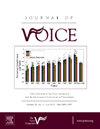用于语言病理学家决策的多参数声学指标 AVQI、ABI 和 DSI 的准确性分析。
IF 2.5
4区 医学
Q1 AUDIOLOGY & SPEECH-LANGUAGE PATHOLOGY
引用次数: 0
摘要
目的:研究声学嗓音质量指数(AVQI)、声学呼吸度指数(ABI)和发音障碍严重程度指数(DSI)的准确性,以便语言病理学家(SLP)在评估教师嗓音状况时做出决策:方法:横断面观察研究,抽取 21 名 "适合 "从事教师工作活动的教师和 21 名 "不适合 "从事教师工作活动的教师作为样本。所有教师都接受了嗓音评估,评估由嗓音专业的语言病理学家进行。嗓音评估包括语言病理学家对教师是否 "适合 "或 "不适合 "工作的意见。用于 AVQI 和 ABI 评分的声音和语音样本为持续元音 /a/ 的三秒中音,以及从 1 到 10 的自发计数。用于提取 DSI 分数的参数如下:持续元音 /a/ 的三秒中音、持续元音 /a/ 的最长发音时间、元音 /a/ 的上升声带滑音直至达到最高音、持续元音 /a/ 的最轻声带强度。用 t 检验比较 AVQI 和 ABI 指数之间的差异。DSI 指数采用 Mann-Whitney 检验,置信度为 95%。准确性分析采用接收器工作特征曲线(ROC):结果:不同组间的 AVQI 值(P=0.008)、ABI 值(P=0.014)和 DSI 值(P=0.000)存在差异。AVQI、ABI和DSI特异性最高的临界点分别为3.33(灵敏度57.1%,特异性90.5%)、4(灵敏度57.1%,特异性85.7%)和1.62(灵敏度71.4%,特异性90.5%):AVQI、ABI 和 DSI 是提供可靠嗓音信息的工具,可以帮助言语病理学家决定是否必须限制教师在工作中的发声活动。本文章由计算机程序翻译,如有差异,请以英文原文为准。
Accuracy Analysis of the Multiparametric Acoustic Indices AVQI, ABI, and DSI for Speech-Language Pathologist Decision-Making
Purpose
To investigate the accuracy of the Acoustic Voice Quality Index (AVQI), the Acoustic Breathiness Index (ABI), and the Dysphonia Severity Index (DSI) for speech-language pathologist (SLP) decision-making in the evaluation of teachers' voice conditions.
Methods
Cross-sectional observational study with a convenience sample composed of 21 teachers “fit” in carrying out their work activities as a teacher, and 21 considered “unfit” for the same. All teachers underwent a voice evaluation, carried out by a voice-specialized speech-language pathologist. Voice evaluation included the SLP's opinion on whether the teachers presented “fit” or “unfit” for work. The voice and speech samples used for the AVQI and ABI scores were the mid-three seconds of a sustained vowel /a/, and a spontaneous count from 1 to 10. The following parameters were used to extract the DSI score: mid-three seconds of a sustained vowel /a/, maximum phonation time of a sustained vowel /a/, ascending vocal glide on the vowel /a/ until reaching the highest pitch, and sustained vowel /a/ at the softest possible vocal intensity. The t-test was used to compare the difference between the AVQI and ABI indices. The Mann-Whitney test was used for the DSI index, with a confidence level of 95%. The receiver operating characteristic curve (ROC) was used for accuracy analysis.
Results
There was a difference in AVQI values (P=0.008), ABI (P=0.014), and DSI (P=0.000) between groups. The cutoff points that revealed the highest specificity for the AVQI, ABI, and DSI respectively were 3.33 (sensitivity 57.1% and specificity 90.5%), 4 (sensitivity 57.1% and specificity 85.7%), and 1.62 (sensitivity 71.4% and specificity 90.5%).
Conclusion
The AVQI, ABI, and DSI are instruments that provide robust voice information and can help speech-language pathologists in their decision-making about whether teachers must or must not be restricted in their vocal activities at work.
求助全文
通过发布文献求助,成功后即可免费获取论文全文。
去求助
来源期刊

Journal of Voice
医学-耳鼻喉科学
CiteScore
4.00
自引率
13.60%
发文量
395
审稿时长
59 days
期刊介绍:
The Journal of Voice is widely regarded as the world''s premiere journal for voice medicine and research. This peer-reviewed publication is listed in Index Medicus and is indexed by the Institute for Scientific Information. The journal contains articles written by experts throughout the world on all topics in voice sciences, voice medicine and surgery, and speech-language pathologists'' management of voice-related problems. The journal includes clinical articles, clinical research, and laboratory research. Members of the Foundation receive the journal as a benefit of membership.
 求助内容:
求助内容: 应助结果提醒方式:
应助结果提醒方式:


